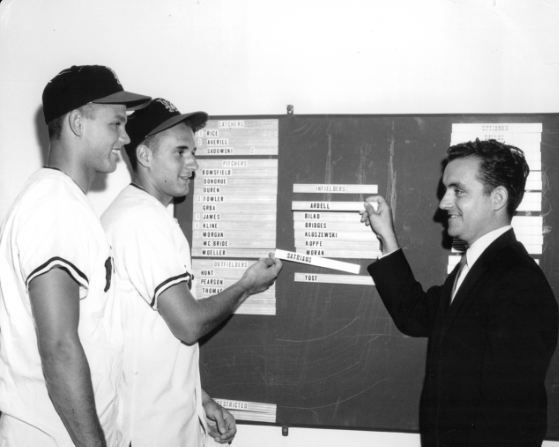

In December of 1941, the landscape of Major League Baseball teetered on the brink of a seismic shift during the Winter Meetings held at Chicago’s Palmer House. At the forefront of discussions was a proposal that could have relocated the struggling St. Louis Browns franchise all the way to Los Angeles, thus establishing the first major professional sports team on the West Coast.
The St. Louis Browns, perennial underdogs overshadowed by the more successful Cardinals in their hometown, saw Los Angeles as a promising new frontier. Ownership, weary of both on-field struggles and the overshadowing presence of the Cardinals, had resolved to move the team westward for the 1942 season. This bold initiative had garnered preliminary approval from fellow team owners, financial backing from A.P. Giannini of Bank of America fame, and logistical arrangements including the acquisition of Los Angeles’ Wrigley Field as their new home stadium.
Crucial to their plans was the acquisition of the Los Angeles Angels, a move that facilitated a clear path for the Browns to establish themselves in Southern California. The timing seemed opportune, with air travel advancements promising to mitigate the logistical challenges posed by the considerable distance between St. Louis and Los Angeles. Even local rivalries and territorial concerns appeared settled, painting a picture of a franchise poised for a transformative move.
Donald Barnes, the Browns’ owner, expressed confidence in Los Angeles as a Major League city, emphasizing its appeal and logistical feasibility amidst growing anticipation. Plans were so advanced that a news conference was scheduled in Los Angeles to formally introduce the team to its prospective new fan base, signaling what could have been a pioneering moment in American sports history.
However, fate intervened with unexpected force. The scheduled vote among team owners, anticipated to ratify the Browns’ move, coincided with a watershed moment in global history: the attack on Pearl Harbor on December 7, 1941. The United States’ entry into World War II immediately reshaped national priorities, rendering the idea of moving a baseball team across the continent untenable amidst wartime constraints.
In a dramatic reversal, the owners convened and unanimously voted against the Browns’ relocation, including the Browns themselves. The burgeoning dream of West Coast Major League Baseball was shelved, postponing the expansion of the sport beyond its established eastern strongholds.
The significance of this decision looms large in hypotheticals. Had the vote occurred even a week earlier, before the world-altering events at Pearl Harbor, or if circumstances had been just slightly different, the Browns could have become the first major sports franchise in California. Imagining an alternate timeline, where the Browns thrived in Los Angeles rather than St. Louis, evokes tantalizing scenarios of sporting dominance and cultural impact.
In this imagined history, the Browns could have carved out a storied legacy in California, potentially rivaling the enduring success of teams like the Los Angeles Dodgers. The prospect of witnessing iconic moments like Don Larsen’s perfect game or cultural touchstones such as “The Sandlot” featuring the Browns instead of the Dodgers paints a vivid picture of what might have been.
Yet, reality prevailed, anchoring the Browns to St. Louis for another twelve years before their eventual relocation to Baltimore in 1953, where they were reborn as the Orioles. This twist of fate forever altered the course of baseball history, setting the stage for the sport’s eventual expansion to the West Coast with the Dodgers and Giants in 1958.
The legacy of the Browns, though often overshadowed by more storied franchises, remains a testament to what might have been—an alternate narrative that underscores the delicate balance of timing and circumstance in shaping the destiny of sports and cultural icons.
In 1948, the Philadelphia Athletics faced a crossroads in their history, fictionalized in a scenario where they contemplate a move to the Bay Area amidst family ownership disputes. In reality, these conflicts would ultimately lead to their relocation to Kansas City in 1955, and later to Oakland in 1968. However, in this alternate narrative, buoyed by the success of the St. Louis Browns in California, the A’s find a new home and prosperity on the West Coast.
The fictional tale envisions the A’s being purchased by San Francisco businessman Paul Fagan, who had previously invested in the Pacific Coast League’s San Francisco Seals. Fagan’s vision and financial backing enable the A’s to establish themselves in San Francisco, leveraging upgrades to Seals Stadium and eventually moving to the iconic Candlestick Park. Later, they move into a state-of-the-art ballpark on San Francisco Bay, becoming a cornerstone of the city’s sports landscape.
This alternate history sees the A’s thriving without the burden of serving as a de facto farm team to the Yankees, unlike their real-life counterparts in Kansas City. They retain young talents like Roger Maris, who achieves several All-Star selections but does not break home run records, defining his career in the blue and red of the San Francisco A’s. The distinctive green and gold colors, later adopted by the Kansas City A’s under Charlie O. Finley, are never introduced in this timeline.
The narrative continues with the Boston Braves’ move to Milwaukee in 1954, a real-life event that remains unchanged in this alternate reality. Meanwhile, the New York Giants, under different circumstances, proceed with their original plan to relocate to Minneapolis. With ownership ties to the Minneapolis Millers and significant local investments, the Giants bring back Willie Mays to Minnesota, where he had previously showcased his prodigious talents.
Mays, having made a memorable impact with the Millers in 1951 before being called up by the Giants, returns as a hero to the fans he had left behind. In this scenario, he becomes a beloved figure in Minnesota, leaving an indelible mark on the Twin Cities over 17 years of play. His legendary status transcends baseball, ingraining him forever in the hearts of Minnesotans.
When the Giants reach the World Series in 1954, they play at Metropolitan Stadium, completed ahead of schedule for narrative purposes. In a pivotal moment during Game 1 against the Cleveland Indians, Vic Wertz’s deep blast to center field secures a three-run homer, propelling the Indians to victory and ultimately the World Series title. The 1954 Indians, with 111 wins, cement their place among the greatest teams in baseball history.
Speculation arises about the potential outcome if Wertz had hit the ball in a ballpark with daunting dimensions, like the Polo Grounds in New York, where Mays’ exceptional speed might have led to a game-changing catch. Such speculation underscores the hypothetical nature of alternate timelines and the enduring allure of what-ifs in baseball lore.
In conclusion, this fanciful retelling of Major League Baseball’s history intertwines real events with imagined scenarios, offering a glimpse into a parallel world where teams and players forge different legacies. It highlights the profound impact of timing and circumstance on sports history, where a single decision or twist of fate can reshape the entire landscape of America’s favorite pastime.
In 1958
A divergent path unfolds for Sandy Koufax and Vin Scully, key figures in Major League Baseball’s history.
In an alternate scenario, despite the departure of the Giants from New York, the Dodgers still grapple with challenges. Ebbets Field remains outdated, and local official Robert Moses’ offer of land in Queens fails to resolve their stadium woes. In our familiar reality, Dodgers’ owner Walter O’Malley opts for the West Coast, leading to their relocation to Los Angeles.
In this alternate timeline, however, with the St. Louis Browns firmly established in Los Angeles, O’Malley seeks a different frontier. Rather than settling for secondary status in another city, he turns his sights to Texas. Specifically, Dallas becomes the new home for the Dodgers, leveraging O’Malley’s ownership of the Minor League Fort Worth Cats post-World War II (in real life, exchanged for rights to Los Angeles).
The Dallas Dodgers—despite the odd fit of the name—quickly thrive. Sandy Koufax, Don Drysdale, and the charismatic Tommy Lasorda propel the team to immediate success. Vin Scully, renowned for his broadcasting prowess, becomes an iconic voice in Texas sports, shaping the narrative of the Dallas Dodgers for generations.
In 1961:
In an alternate scenario:
- Fantasy: The Angels are admitted into the National League.
- Reality: The Angels join the American League.
During a period of significant baseball expansion in the 1960s, this alternate timeline sees the Angels joining the NL. The American League, seeking a foothold in Southern California and eager to fend off the proposed Continental League, has already established itself there for two decades. When Gene Autry’s new team, the Angels, arrives, it does so in the NL. Fast forward to later decades, and despite missing out on the designated hitter rule, the Angels still manage to draft Mike Trout. However, without the DH, Shohei Ohtani opts for the Browns instead. Meanwhile, Albert Pujols signs elsewhere after leaving the Cardinals, influenced by the absence of the DH.
Consequently, the Dodgers make three trips annually to Los Angeles as the visiting team, plus an additional visit whenever they face the Browns in Interleague Play.
In reality:
- The Angels are admitted into the American League.
Baseball undergoes substantial expansion in the 1960s, with the Angels joining the AL. The league aims to establish a presence in Southern California and counter the proposed Continental League. Having been established in the region for two decades, the AL welcomes Gene Autry’s new team, the Angels.
From 1977 onward, the course of events largely mirrors our own reality, with a few notable exceptions.
Baseball continues its expansion with Toronto joining in ’77. However, unlike in our timeline where the Pilots relocated to Milwaukee after one season, they remain in Seattle due to local ownership stepping in. San Diego’s Mayor Pete Wilson, who would later become California’s governor, threatened legal action when the Padres breached their lease, resulting in the city receiving an expansion team in the American League. This mirrors how the Mariners and Royals were actually formed. The new San Diego team retains the name Padres, just as the real-life Senators did after their predecessors departed.
Further expansion occurs with Denver and Miami receiving teams in ’93, followed by Phoenix and Tampa Bay in ’98. Ironically, despite considerations to move to Oakland later on, the Tampa Bay team ultimately remains in their original location at the Oakland Coliseum, avoiding relocation.
In the present day, Major League Baseball in 2024 appears markedly different. Some aspects of this alternate reality might seem unimaginable, much like some of the actual events that transpired in our timeline. Had the Browns relocated to Los Angeles in 1942, baseball today would undoubtedly bear little resemblance to the detailed scenario we’ve just described. Yet, it also wouldn’t mirror the current state of the game as we know it.
Reflecting on the missed opportunity in 1957, former Browns owner Barnes remarked to the Sporting News:
“What’s so remarkable about that? The National League is 16 years late. If you remember, we missed putting American League baseball — the St. Louis Browns — in Los Angeles by just one day for the start of the 1942 season.”
The mere difference of a single day could have dramatically altered the entire course of baseball history, in ways that are truly staggering and difficult to fathom.

Leave a Reply